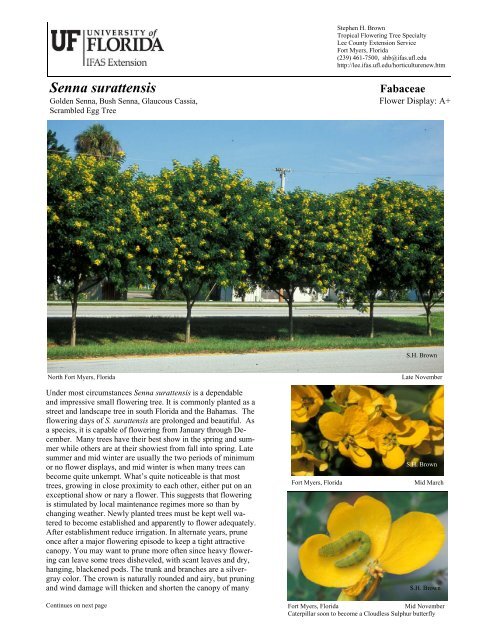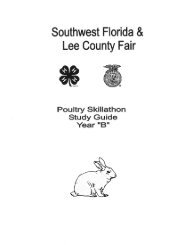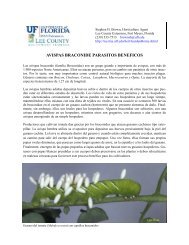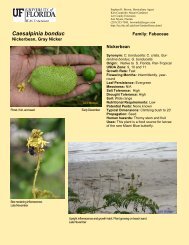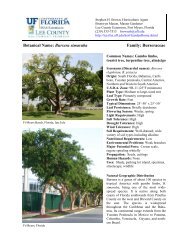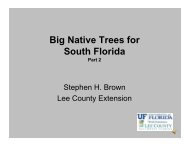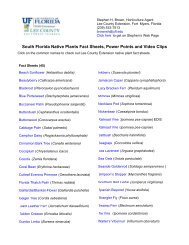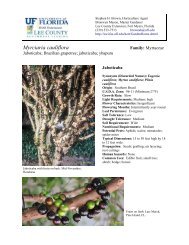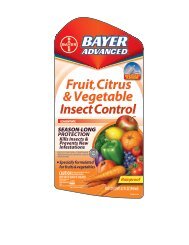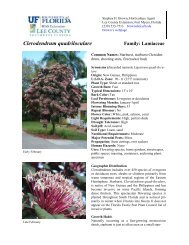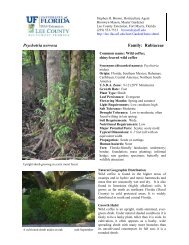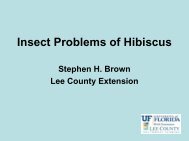Senna surattensis - Lee County Extension - University of Florida
Senna surattensis - Lee County Extension - University of Florida
Senna surattensis - Lee County Extension - University of Florida
You also want an ePaper? Increase the reach of your titles
YUMPU automatically turns print PDFs into web optimized ePapers that Google loves.
Stephen H. Brown<br />
Tropical Flowering Tree Specialty<br />
<strong>Lee</strong> <strong>County</strong> <strong>Extension</strong> Service<br />
Fort Myers, <strong>Florida</strong><br />
(239) 461-7500, shb@ifas.ufl.edu<br />
http://lee.ifas.ufl.edu/horticulturenew.htm<br />
<strong>Senna</strong> <strong>surattensis</strong> Fabaceae<br />
Golden <strong>Senna</strong>, Bush <strong>Senna</strong>, Glaucous Cassia, Flower Display: A+<br />
Scrambled Egg Tree<br />
Under most circumstances <strong>Senna</strong> <strong>surattensis</strong> is a dependable<br />
and impressive small flowering tree. It is commonly planted as a<br />
street and landscape tree in south <strong>Florida</strong> and the Bahamas. The<br />
flowering days <strong>of</strong> S. <strong>surattensis</strong> are prolonged and beautiful. As<br />
a species, it is capable <strong>of</strong> flowering from January through December.<br />
Many trees have their best show in the spring and summer<br />
while others are at their showiest from fall into spring. Late<br />
summer and mid winter are usually the two periods <strong>of</strong> minimum<br />
or no flower displays, and mid winter is when many trees can<br />
become quite unkempt. What’s quite noticeable is that most<br />
trees, growing in close proximity to each other, either put on an<br />
exceptional show or nary a flower. This suggests that flowering<br />
is stimulated by local maintenance regimes more so than by<br />
changing weather. Newly planted trees must be kept well watered<br />
to become established and apparently to flower adequately.<br />
After establishment reduce irrigation. In alternate years, prune<br />
once after a major flowering episode to keep a tight attractive<br />
canopy. You may want to prune more <strong>of</strong>ten since heavy flowering<br />
can leave some trees disheveled, with scant leaves and dry,<br />
hanging, blackened pods. The trunk and branches are a silvergray<br />
color. The crown is naturally rounded and airy, but pruning<br />
and wind damage will thicken and shorten the canopy <strong>of</strong> many<br />
Continues on next page<br />
S.H. Brown<br />
North Fort Myers, <strong>Florida</strong> Late November<br />
S.H. Brown<br />
Fort Myers, <strong>Florida</strong> Mid March<br />
S.H. Brown<br />
Fort Myers, <strong>Florida</strong> Mid November<br />
Caterpillar soon to become a Cloudless Sulphur butterfly
S.H. Brown<br />
Fort Myers, <strong>Florida</strong> Late November<br />
S.H. Brown<br />
Fort Myers, <strong>Florida</strong> Late November<br />
Leaves: Even-pinnate, alternate, dark green, to about 7 inches long usually having 6-9 opposite<br />
pairs <strong>of</strong> obovate to oblong leaflets<br />
Flowers: Yellow with 10 stamens to 1-1 ½ inches wide in semi-erect panicles<br />
Fruits: Pods, flat, papery to about 7 inches long<br />
S.H. Brown<br />
Naples, <strong>Florida</strong> Early October<br />
Continued from previous page<br />
trees. Easily toppled by wind, S. <strong>surattensis</strong><br />
should probably be staked<br />
for up to three years after planting or<br />
until it becomes properly established.<br />
It is generally not a long-lived tree,<br />
and will usually not survive for more<br />
than 6 years under normal streetscape<br />
conditions. However, properly<br />
tended, it can live for more than 10<br />
years. This means keeping it properly<br />
standing and maintaining it free <strong>of</strong><br />
scales and the pink hibiscus mealybug.<br />
Typical <strong>of</strong> this genus, S. <strong>surattensis</strong><br />
attracts egg-laying cloudless<br />
sulfur butterflies. The caterpillars<br />
feed on the leaves and flowers <strong>of</strong> the<br />
tree. However, caterpillar feeding<br />
does little to detract from the beauty<br />
<strong>of</strong> its magnificent displays. Maintain<br />
a fertilizer schedule for best appearance.
S.H. Brown<br />
North Fort Myers, <strong>Florida</strong> Mid August<br />
Hurricane toppled <strong>Senna</strong> Surattensis<br />
S.H. Brown<br />
Fort Myers, <strong>Florida</strong> Mid December<br />
Scale insects can cause stem die-back<br />
Golden <strong>Senna</strong><br />
Syn: Cassia glauca, Cassia <strong>surattensis</strong><br />
Origin: India, Southeast Asia, Tropical<br />
Australia<br />
Zone: 9b-12b, 20ºF<br />
Growth Rate: Fast<br />
Flowering Months: January through<br />
December<br />
Flowering Days:<br />
Leaf Persistence: Evergreen to Semi-<br />
Deciduous<br />
Messiness: Moderate<br />
Salt Tolerance: Low<br />
Drought Tolerance: Medium<br />
Nutritional Requirements: Medium<br />
Potential Pests: Caterpillars, Hibiscus<br />
Mealybugs, Scales<br />
Typical Dimensions: 14’x11’<br />
Uses: Butterfly Garden, Container, Garden,<br />
Park, Parking Lot, Poolside, Streetscape<br />
The Institute <strong>of</strong> Food and Agricultural Sciences (IFAS) is an Equal Opportunity Institution authorized to provide research, educational information and<br />
other services only to individuals and institutions that function with non-discrimination with respect to race, religion, age, disability, sex, sexual orientation,<br />
martial status, national origin, political opinions or affiliations. U.S. Department <strong>of</strong> Agriculture, Cooperative <strong>Extension</strong> Service, <strong>University</strong> <strong>of</strong><br />
<strong>Florida</strong>, IFAS, <strong>Florida</strong> A. & M.


